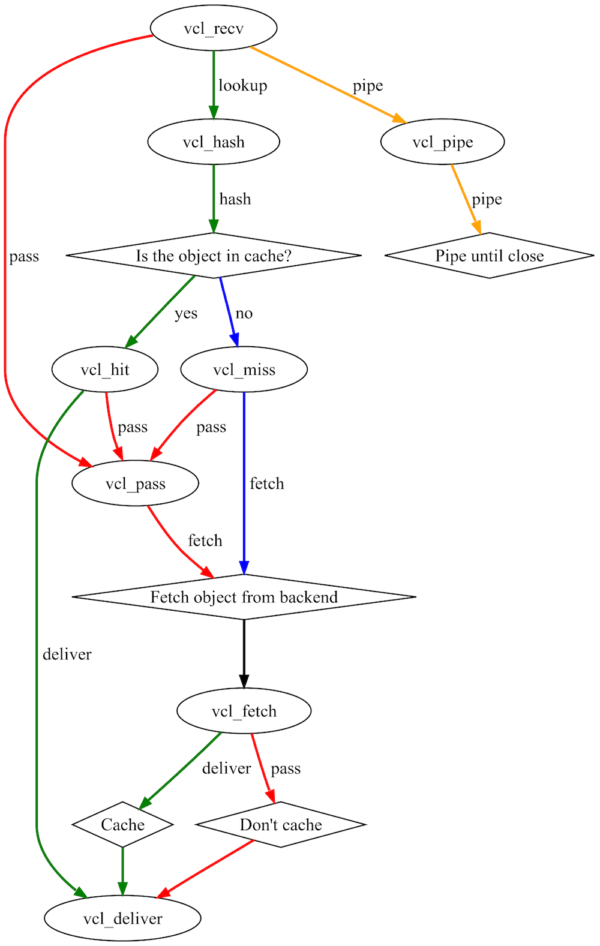性能主题
使用Varnish加速Web性能
Varnish是一个受欢迎的缓存HTTP反向代理。Nginx虽然是作为一个伟大的反向代理,它没有缓存。当网站或Web应用程序静态内容很多时需要缓存。而动态的Web应用程序可能不会从缓存得到优化。
Varnish位于所有HTTP兼容的服务器之前,它可以被配置为选择性地缓存相应内容。它提供缓存的内容几乎肯定会比直接到后端的请求要快。
Varnish会自动尝试缓存任何请求处理,一下情况除外:
- 它不会缓存请求中所包含的Cookie标头或授权的标题。
- 它不会缓存请求的后端响应中表明不应该被缓存(例如高速缓存控制:无缓存)。
- 它只会缓存GET和HEAD请求。
- 缓存默认值120秒。取决于所请求的资源的类型,这可能需要调整。
- 提供任何失效期/修改/缓存控制头,除非被后端响应覆盖。
必须了解Varnish几个子程序:
- vcl_recv:在请求开始叫。它决定是否为一个请求服务,是否修改请求,而使用哪个后端。
- vcl_hash:为请求创建一个哈希数据,作为对象缓存中该请求的识别(key/value)。
- vcl_pass:如果配置pass模式被调用,当前请求传递到后端并响应是没有被缓存的。
- vcl_hit:类似缓存的击中。
- vcl_miss:类似缓存的丢失。
- vcl_fetch:当在资源从后端被获取时调用,它决定是否缓存后端响应,以及如何做,是否在缓存时修改对象。
- vcl_deliver:在一个缓存对象传递给一个客户前被调用。
- vcl_pipe:如果管道模式被初始化时调用,在管道模式,当前的连接请求通过直接到后端,响应同样返回没有被缓存,直到连接关闭。
Varnish每个子程序对应一个Action:
- deliver: 插入对象到缓存中,最终流程到vcl_deliver.
- error: 返回错误代码给客户端。
- fetch: 从后端抓取请求的对象,最终流程是vcl_deliver.
- hit_for_pass:创建一个传递对象缓存命中的事实,这个对象应该被通过了。流最终将达到vcl_deliver。
- lookup: 查找对象缓存中请求。流最终将通过达到vclhit或vclmiss,取决于对象存在于缓存。
- pass: 激活pass模式。流最终将达到vcl_pass。
- pipe: 管模式激活。流最终将达到vcl_pipe
- hash: 创建请求数据的哈希,缓存中查找相关的对象
上述状态和动作的流程:

VCL配置案例:
vcl_recv
sub vcl_recv {
# Many requests contain Accept-Encoding HTTP headers. We standardize and remove these when unnecessary to make it easier to cache requests
if (req.http.Accept-Encoding) {
# If the request URL has any of these extensions, remove the Accept-Encoding header as it is meaningless
if (req.url ~ '\.(gif|jpg|jpeg|swf|flv|mp3|mp4|pdf|ico|png|gz|tgz|bz2)(\?.*|)$') {
remove req.http.Accept-Encoding;
# If the Accept-Encoding contains 'gzip' standardize it.
} elsif (req.http.Accept-Encoding ~ 'gzip') {
set req.http.Accept-Encoding = 'gzip';
# If the Accept-Encoding contains 'deflate' standardize it.
} elsif (req.http.Accept-Encoding ~ 'deflate') {
set req.http.Accept-Encoding = 'deflate';
# If the Accept-Encoding header isn't matched above, remove it.
} else {
remove req.http.Accept-Encoding;
}
}
# Many requests contain cookies on requests for resources which cookies don't matter -- such as static images or documents.
if (req.url ~ '\.(gif|jpg|jpeg|swf|css|js|flv|mp3|mp4|pdf|ico|png)(\?.*|)$') {
# Remove cookies from these resources, and remove any attached query strings.
unset req.http.cookie;
set req.url = regsub(req.url, '\?.*$', '');
}
# Certain cookies (such as for Google Analytics) are client-side only, and don't matter to our web application.
if (req.http.cookie) {
# If a request contains cookies we care about, don't cache it (return pass).
if (req.http.cookie ~ '(mycookie1|important-cookie|myidentification-cookie)') {
return(pass);
} else {
# Otherwise, remove the cookie.
unset req.http.cookie;
}
}
}
vcl_fetch
sub vcl_fetch {
# If the URL is for our login page, we never want to cache the page itself.
if (req.url ~ '/login' || req.url ~ 'preview=true') {
# But, we can cache the fact that we don't want this page cached (return hit_for_pass).
return (hit_for_pass);
}
# If the URL is for our non-admin pages, we always want them to be cached.
if ( ! (req.url ~ '(/admin|/login)') ) {
# Remove cookies...
unset beresp.http.set-cookie;
# Cache the page for 1 day
set beresp.ttl = 86400s;
# Remove existing Cache-Control headers...
remove beresp.http.Cache-Control;
# Set new Cache-Control headers for brwosers to store cache for 7 days
set beresp.http.Cache-Control = 'public, max-age=604800';
}
# If the URL is for one of static images or documents, we always want them to be cached.
if (req.url ~ '\.(gif|jpg|jpeg|swf|css|js|flv|mp3|mp4|pdf|ico|png)(\?.*|)$') {
# Remove cookies...
unset beresp.http.set-cookie;
# Cache the page for 365 days.
set beresp.ttl = 365d;
# Remove existing Cache-Control headers...
remove beresp.http.Cache-Control;
# Set new Cache-Control headers for browser to store cache for 7 days
set beresp.http.Cache-Control = 'public, max-age=604800';
}
}
vcl_deliver
sub vcl_deliver {
# Sometimes it's nice to see when content has been served from the cache.
if (obj.hits > 0) {
# If the object came from the cache, set an HTTP header to say so
set resp.http.X-Cache = 'HIT';
} else {
set resp.http.X-Cache = 'MISS';
}
# For security and asthetic reasons, remove some HTTP headers before final delivery...
remove resp.http.Server;
remove resp.http.X-Powered-By;
remove resp.http.Via;
remove resp.http.X-Varnish;
}